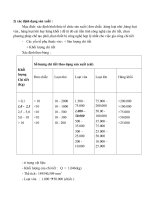Cải tiến về công nghệ stent ảnh hưởng thế nào đến quyết định can thiệp mạch vành
Bạn đang xem bản rút gọn của tài liệu. Xem và tải ngay bản đầy đủ của tài liệu tại đây (3.27 MB, 37 trang )
Ở BỆNH NHÂN NGUY CƠ CAO
CÁC CẢI TIẾN VỀ CÔNG NGHỆ VÀ THUỐC CÓ GIÚP
CÁC STENT PHỦ THUỐC KHÁC BIỆT NHAU?
In high risk patients does stent technology evolution make
DES different from each other?
VÕ THÀNH NHÂN MD, PhD, FSCAI
Disclosure
Speaker name: Võ Thành Nhân
I have the following potential conflicts of interest to report:
Consulting
Employment in industry
Stockholder of a healthcare company
Owner of a healthcare company
Speaker’s Honoraria: from Abbott, BSc, Medtronic, Terumo,
St Jude, Biotronik, Elixir, AGA, B Braun, United Healthcare
I do not have any potential conflict of interest
Coronary stenting - timeline
Restenosis rate
1970
1980
1969 Charles Theodore
Dotter invents first
coronary stent,
experimenting on dogs.
~4-5%
~20-30%
~30-40%
1990
1986 Jacques Puel
implants first stent.
minimal LL with DES & 74% reduction in TLR
2000
2008 2nd gen DES:
Xience (EES),
Endeavor, Resolute
(ZES)
2010
2014 DES
recommended
over BMS in
ESC guidelines.
2011 Newer Gen
DES Orsiro (SES)
2009 DES regain
terrain.
1970
1980
1990
2000
2010
2006 ESC firestorm,
concern about DES
safety
1977 Andreas
Gruentzig performs
first PTCA on human.
1999 Adjunctive antiplatelet medication
becomes standard.
Stenting composes
84% of all PCI.
2003 Launch of Taxus.
2002 Launch of Cypher.
Important stent characteristics
Characteristic
Definition
Determinants
Biocompatibility
Resistance to corrosion, thrombosis
Materials, coatings,
metal surface area
Conformability
Degree to which an expanded stent can bend around its
longitudinal axis
Material, stent design
Deliverability
Ability to deliver stent to target lesion
Longitudinal flexibility, crossing profile, trackability,
nesting
Outer contour
Separation of the stent strut from the delivery balloon during
insertion around bends
Stent design
(bigger problems with open or coil designs)
Flexibility
Degree to which an unexpanded stent can bend around its
longitudinal axis
Material, stent design
Metal surface area
Percent of surface area covered by metal after stent deployment
Stent design, strut thickness
Nesting
Security of stent attachment to delivery system
Stent design, profile
Radial strength
Resistance to vessel recoil
Stent design, strut thickness
Radiopacity
Ability to identify stent during fluoroscopy
Strut thickness, material
Scaffolding
Ability of stent to completely cover and support the vessel
Material, stent design, strut thickness, metal surface
area, radial strength
Trackability
Ease of movement over guide wire
Profile, shaft coating, stiffness, distal tapering
“Fish scaling„
Source:
Watson and Gorski. Invasive Cardiology: A manual for cath lab personnel. 2000/
Background
• The optimal management of patients at high risk of adverse clinical events
remains a challenging clinical problem.
• Newer-generation DES with durable polymer (DP-DES):
– significantly improved safety and efficacy outcomes (death, MI, TVR,
stent thrombosis), compared with both BMS and early-generation
durable polymer DES;
– represent the current standard-of-care for PCI in all patient and lesion
subsets.
• Newer-generation DP-DES in high-risk patients remain associated with
higher rates of DES failure, including ISR, TVR and late/very late stent
thrombosis.
Background (Con’t)
• Permanent polymer coatings on newer-generation DP-DES:
– recently associated with chronic inflammation, hypersensitivity reactions, and
neoatherosclerosis, resulting in persisting late thrombotic events;
– concerns about long-term durable polymer biocompatibility.
• Biodegradable polymer DES (BP-DES):
- recently introduced to overcome current limitations of newer-generation DP-DES.
- enhance biocompatibility, promote vascular healing, reduce inflammation and
hypersensitivity reactions, and reduce long-term adverse outcomes.
- safe and effective alternative to newer-generation DP-DES in large all-comers
Populations.
• Long-term potential benefit of BP-DES for the management of high-risk
subgroups remains unclear.
In-Stent Restenosis in High-Risk Subgroup
INCIDENCE OF ANGIOGRAPHICALLY DOCUMENTED IN-STENT RESTENOSIS (1998-2009, N=12’904)
PREDICTORS OF ISR
Cassese S, Heart 2014
LONG-TERM MORTALITY
Cassese S, Eur Heart J 2015
Stent Thrombosis in High-Risk Subgroup
PREDICTORS AND INCIDENCE OF LATE/VERY LATE STENT THROMBOSIS
PREDICTORS OF STENT THROMBOSIS @ 3 YEARS (N=18’334)
DEFINITE/PROBABLE STENT THROMBOSIS @ 1 YEAR (N=12’198)
HR 3.07
Tada T, J Am Coll Cardiol Intv 2013
Loh JP, Am J Cardiol. 2014
Recent Developments in DES Technology
Overview of Current Stents Designs
NEW METALLIC PLATFORM MATERIALS
THINNER STRUTS
THINNER, MORE BIOCOMPATIBLE/BIODEGRADABLE POLYMERS
NEW LIMUS-ANALOGUES ANTIPROLIFERATIVE DRUGS
REDUCED DRUG LOAD
IMPROVED CONTROLLED DRUG RELEASE
IMPROVE BIOCOMPATIBILITY, REDUCE CHRONIC INFLAMMATION
AND HYPERSENSITIVITY REACTIONS.
Iglesias JF, Minerva Cardioangiologica 2015 (adapted from Stefanini GG, Heart 2014)
Newer-Generation Biodegradable Polymer DES
ORSIRO® DRUG-ELUTING STENT (BIOTRONIK AG, SWITZERLAND)
UNIQUE HYBRID TECHNOLOGY
ULTRATHIN STRUTS
REDUCE THROMBOGENICITY
(PLATELET ADHESION)
BIOCOMPATIBLE POLYMER
BIOABSORBABLE POLYMER
THIN POLYMER COATING
REDUCED LIMUS DRUG LOAD
REDUCE INFLAMMATORY RESPONSE, IMPROVE ENDOTHELIALIZATION, PROMOTE VASCULAR HEALING
The clinical program for Orsiro is
comprehensive and well underway
Study
Primary
endpoint
Status
ClinicalTrials.gov
Identifier:
30
9 mo LLL
Completed
NCT01214148
RCT vs. Xience Prime
440
9 mo LLL
Primary endpoint
reached
NCT01356888
International registry
1,356
12 mo TLF
Primary endpoint
reached
NCT01553526
>3,000
12 mo TLF
Enrolling
555
12 mo TVF
Enrollment completed
NCT01939249
RCT vs. Xience
1,334
12 mo TLF
Enrolling
NCT02389946
RCT vs. Xience
440
9 mo LLL
Enrolling
Indian single-armed trial
120
9 mo LLL
Completed
NCT01426139
RCT vs. Pantera Lux in ISR
210
6 mo LLL
Enrollment completed
NCT01651390
Study design
BIOTRONIK initiated
FIM
Satellite registries (14)
RCT vs. Xience
Prime/Xpedition
Total
patients
Sources: www.clinicaltrials.gov/ct2/results?term=orsiro; Investigator updates
Investigator initiated
The clinical program for Orsiro is
comprehensive and well underway
Total
patients
Primary
endpoint
Status
ClinicalTrials.g
ov Identifier:
RCT vs. Xience Prime
2,100
12 mo TLF
Primary endpoint
reached
NCT01443104
SORT OUT VII
RCT vs. Nobori
2,525
12 mo TLF
Primary endpoint
reached
NCT01879358
BIO-RESORT
RCT vs.
Synergy & Resolute integrity
3,530
12 mo TVF
Enrolling
NCT01674803
ORIENT
RCT vs. Resolute Integrity
375
9 mo LLL
Enrollment completed
NCT01826552
PRISON-IV
RCT vs. Xience Prime
330
9 mo LLL
Enrolling
NCT01516723
HAT-TRICK-OCT
RCT vs. Endeavor Resolute
40
3 mo
Strut coverage
Primary endpoint
reached
NCT01391871
ISAR OCT
RCT vs. Xience Prime
87
6 & 24 mo
Strut coverage
Enrollment completed
NCT01594736
Enrolling
NCT02079194
Study
Study design
BIOSCIENCE
SMART-Choice
RCT vs. Promus and Xience
5,100
3-15 mo
Composite of
Death, MI and
cerebrovascular
events
Revolute Registry
Orsiro, Elixir DESyne,
Biomatrix Flex, Cilotax
1,000
12 mo MACE
Enrolling
BIODEGRADE
RCT vs. Biomatrix Flex
3,850
18 mo TLF
Enrolling
NCT02299011
BIONYX
RCT vs. Onyx
2,470
12 mo TVF
Enrolling
NCT02508714
Total >26,000
Sources: www.clinicaltrials.gov/ct2/results?term=orsiro; Investigator updates
Safety and Clinical Performance of the Orsiro DES in
the treatment of subjects with single de novo
coronary artery lesions
DESIGN
An international, prospective, multi-center,
randomized, controlled trial comparing the
Orsiro hybrid DES to Xience Prime
OBJECTIVE
To compare the Orsiro stent with a
bioabsorbable polymer to the XIENCE
Prime® stent with a durable polymer for the
treatment of de novo coronary lesions with
respect to non-inferiority for in-stent Late
Lumen Loss (LLL) at 9-months
COORDINATING CLINICAL
INVESTIGATORS
Prof. Stephan Windecker, Bern, Switzerland
Dr. Thierry Lefèvre, Massy, France
PRIMARY ENDPOINT
In-Stent Late Lumen Loss at 9-month
Source: T. Slagboom, Poster, EuroPCR 2015
440 Patients with stable CAD
2:1 randomization
Orsiro
Xience Prime
Clinical follow-up at 1 and 6- months
Clinical, angiographic, IVUS* and OCT*
follow-up at 9 months
* Pre-specified subgroups with
60 patients in each
Clinical follow-up at 12 months
Clinical follow-up to 5 years
Primary Angiographic Endpoint
ULTRATHIN-STRUT BP-SES vs. THIN-STRUT DP-EES (RCT, 2:1, N=452)
IN-STENT LATE LUMEN LOSS @ 9 MONTHS
Windecker S, Circ Cardiovasc Interv. 2015
Secondary Clinical Composite Endpoint
ULTRATHIN-STRUT BP-SES vs. THIN-STRUT DP-EES (RCT, 2:1, N=452)
TARGET LESION FAILURE @ 36 MONTHS
TLF univ. def. (%)
20
P=0.5800
Orsiro BP-SES
Xience DP-EES
10.6%
9.0%
10
0.0
0
180
365
730
1095
days after PCI
Composite endpoints (%)
Orsiro
N=298
Xience
N=154
P value
Cardiac Death
0.7
1.3
0.5069
Target vessel MI
3.4
2.6
0.6590
TLR (clinically driven)
5.6
6.7
0.6361
CABG (emergent)
0.0
0.0
>0.9999
Slagboom et al. Poster EuroPCR 2015, Paris, France
High-Risk Subgroups Diabetics
TARGET LESION FAILURE @ 36 MONTHS
TLF univ. def. (%)
20%
P=0.6021
Orsiro
Xience
Prime
10%
0.0%
0
12.3%
9.1%
180
365
730
1095 days after PCI
Composite endpoints (%)
Orsiro
N=84
Xience
N=44
P value
Cardiac Death
0.0
2.3
0.3437
Target vessel MI
1.2
0.0
>0.9999
TLR (clinically driven)
11.1
6.9
0.4688
CABG (emergent)
0.0
0.0
>0.9999
Slagboom et al. Poster EuroPCR 2015, Paris, France
High-Risk Subgroups Small Vessels
TARGET LESION FAILURE @ 36 MONTHS
P=0.3494
TLF univ. def. (%)
20%
14.4%
Orsiro
Xience Prime
10.6%
10%
0.0%
0
180
365
730
1095
days after PCI
Composite endpoints (%)
Orsiro
N=168
Xience
N=91
P value
Cardiac Death
0.0
1.1
0.3514
Target vessel MI
3.7
4.4
0.7475
TLR (clinically driven)
8.1
8.9
0.8249
CABG (emergent)
0.0
0.0
>0.9999
Slagboom et al. Poster EuroPCR 2015, Paris, France
Long term Safety Endpoint
STENT THROMBOSIS @ 36 MONTHS
OVERALL POPULATION
HIGH-RISK SUBGROUPS
ST (%)
Orsiro
Xience
Prime
10
DIABETICS
10
P=0.3437
0.0
0
ST (%)
P=0.3407
10
0.0%
365
SMALL VESSELS
ST (%)
0.7%
0.0
180
P>0.9999
0.0
0
180
365
730
1095
Days after PCI
2.3%
0.0%
730
1095
Days after PCI
0
0.0%
180
365
730
1095
Days after PCI
COMPARABLE LONG-TERM EFFICACYAND SAFETY AS BEST-IN-CLASS NEWER GENERATION DP-DES
IN AN OVERALL LOW-RISK PATIENT POPULATION AND IN HIGH-RISK SUBGROUPS
Slagboom et al. Poster EuroPCR 2015, Paris, France
OCT results at 9 months
Neointimal Area
Apposition and Coverage
Orsiro
Xience
Prime
P
98.6%
98.8%
0.62
Incomplete Strut
Apposition
1.0%
0.6%
0.32
Non-apposed side
branch
0.4%
0.6%
0.37
100%
100%
98.3%
97.5%
100
Mean value
0.74± 0.38
mm2
90
Percent of lesions (%)
80
Well-apposed
struts
70
P=0.024
60
50
Mean value
1.00± 0.44 mm2
40
30
Sum
20
Orsiro
Xience Prime
10
Covered Struts
0
0.2
0.4
0.6
0.8
1
1.2
1.4
1.6
1.8
2
2.2
Median of neo-intimal area (mm2)
Source: S. Windecker, Late breaking trial presentation, EuroPCR 2013
0.042
Orsiro has also shown superior strut
coverage compared to Resolute Integrity
HATTRICK-OCT study
•
Orsiro v.s. Resolute Integrity (n=44, 1:1 randomization)
•
To access “early healing pattern of 2nd and 3rd
generation DES”
•
Primary endpoint: Stent strut coverage at 3 months
•
Presented at EuroPCR 2013 by T. Kiviniemi, PI: P
Karjalainen
•
No significant baseline differences between study arms
•
Most interesting result – Uncovered struts at 3 months
Orsiro 3.9% vs. Resolute Integrity 8.9%, p<0.001
•
Conclusion
“Sirolimus-eluting stents with bioabsorbable polymer
were more completely covered compared to
zotarolimus-eluting stents with durable polymer at 3
months after PCI for ACS”
Published in Official Journal of the Japanese
Circulation Society December 2014
/>
Registry for an all-comers patient population
with the limus eluting Orsiro stent system in
daily clinical practice
DESIGN
An international, prospective, multi-center
open-label, registry of the Orsiro hybrid DES
in daily clinical practice
OBJECTIVE
Evaluate safety and clinical performance of the
Orsiro drug eluting stent with a bioabsorbable
polymer in a large patient population in standard
clinical care
COORDINATING INVESTIGATOR
Prof. Dr. Johannes Waltenberger,
Universitätsklinikum Münster, Germany
PRIMARY ENDPOINT
Target Lesion Failure (TLF) at 12 months
NCT01553526
1’356 all-comers patients
Predefined subgroups
Diabetic patients
Acute MI (STEMI and NSTEMI)
Small vessels (≤2.75 mm)
Chronic Total Occlusion
Clinical follow-up at 6 months
Clinical follow-up at 12 months*
Clinical follow-up at 36 months
Clinical follow-up at 60 months
* 97.4 % FUP compliance
Source: Waltenberger et al. EuroIntervention 2015; 10-online publish-ahead-of-print March 2015.
.
Primary Efficacy and Safety Endpoints
TARGET LESION FAILURE @ 12 MONTHS
DEFINITE STENT THROMBOSIS @ 12 MONTHS
LOW TLF AND ST RATES IN AN UNSELECTED, ALL-COMERS POPULATION
WITH COMPLEX CORONARY ARTERY DISEASE
Waltenberger J, Eurointervention 2015
Primary Efficacy Composite Endpoint
ULTRATHIN-STRUT BP-SES vs. THIN-STRUT DP-EES @ 2 YEARS (N=2’119)
12
10.5% - BP SES
RR (95%CI)=1.00 (0.77-1.31)
P= 0.98
11
10
PRIMARY ENDPOINT TLF @ 1 YEAR
9
10.4% - DP EES
TLF (%)
8
7
PNON INFERIORITY
= 0.0004
6.7% - DP EES
6.7% - BP SES
6
5
4
3
2
1
0
0
60
120
180
240
300
360
420
480
Days since index procedure
Zbinden R, J APimlgrHimea
540
600
660
730
Composites of Primary Efficacy Endpoint
ULTRATHIN-STRUT BP-SES vs. THIN-STRUT DP-EES @ 2 YEARS (N=2’119)
10.5% - BP SES
10.4% - DP EES
6
5
3.2% - DP EES
4
3
2
3.2% - BP SES
0
0
60
120 180 240 300 360 420 480 540
600 660
730
935 929 924 917
928 918 911 908
907
889
8
RR (95%CI)=0.91 (0.60-1.39), P=0.67
6
4.5% - DP EES
5
4
3
4.1% - BP SES
2
0
1
0
Number at risk
DP-EES 1056 1036 1033 1030 1030 1022 1014 992 989 988 986 985
BP-SES 1063 1036 1031 1026 1022 1014 1007 988 984 976 974 971
8
7
6
5
4
3
2
1
0
60
120 180 240 300 360 420
480 540 600 660
730
Days since index procedure
Number at risk
DP-EES 1056 1013 1009 1004 1000 990 981 959 955 953 948 944
BP-SES 1063 1017 1011 1002 995 987 979 957 949 941 936 933
Zbinden R, J Am Heart Assoc. 2016
937
922
730
979
960
RR (95%CI)=1.17 (0.81-1.71), P=0.40
6.0% - BP SES
5.1% - DP EES
0
0
60 120 180 240 300 360 420 480 540 600 660
Days since index procedure
TLR clinically driven (%)
Days since index procedure
Target vessel MI (%)
RR (95%CI)=1.01 (0.62-1.63), P=0.98
7
1
Number at risk
DP-EES 1056 1007 1001 996 988 975 965 940
BP-SES 1063 1012 1002 989 975 967 958 935
7
8
Cardiac death (%)
RR (95%CI)=1.00 (0.77-1.31), P=0.98
TLF
(%)
11
10
9
8
7
6
5
4
3
2
1
0
60
120 180 240 300 360 420 480 540 600 660
730
Days since index procedure
Number at risk
DP-EES 1056 1028 1023 1019 1013 1000 990 965 961 955 948 941
BP-SES 1063 1027 1017 1005 992 983 974 950 944 934 929 925
931
908
Subgroup Analysis
Primary Efficacy Composite Endpoint
ULTRATHIN-STRUT BP-SES vs. THIN-STRUT DP-EES @ 2 YEARS (N=2’119)
TARGET LESION FAILURE ACROSS PRESPECIFIED SUBGROUPS
STRONG SIGNAL TOWARDS A SIGNIFICANT REDUCTION IN TLF
IN THE PRESPECIFIED SUBGROUP OF PATIENTS WITH STEMI
Zbinden R, J Am Heart Assoc. 2016









